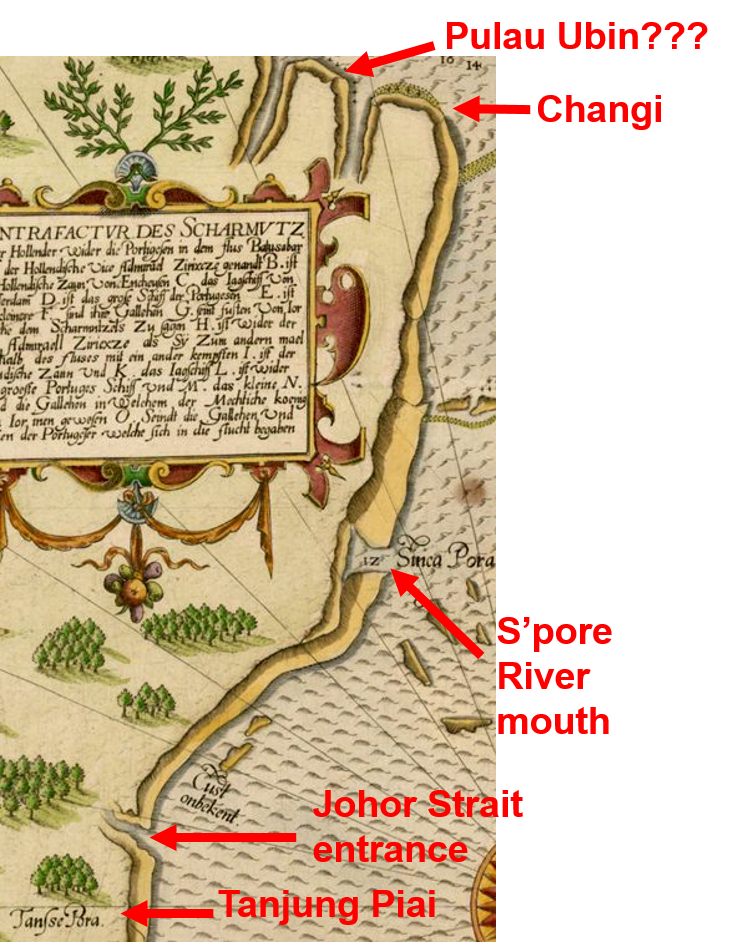Name: Folio 26, Historia de Servicos com Martiro de Luis Monteiro Coutinho
Year: 1615
Map maker: Manuel Godinho de Erédia
Manuscript map location: Biblioteca Nacional Lisbon, Cod. 414
C. Rio de Jor : Johor River
D. Tanjon Rusa : Tanjong Rusa (Present day Changi Point)
E. Luís Monteiro Coutinho
F. Mathias de Albuquerque
References
[1] P. J. de Sousa Pinto, The Portuguese and the Straits of Melaka, 1575-1619 (NUS Press, Singapore, 2012) pp 276-278.
[2] A pdf file of Historia de Servicos com Martiro de Luis Monteiro Coutinho can be download from this link.
Year: 1615
Map maker: Manuel Godinho de Erédia
Manuscript map location: Biblioteca Nacional Lisbon, Cod. 414
 |
| Figure 1. A 1615 map that portrays a naval battle on the 1st of Jan. 1577, between the Portuguese and Acehnese just south of present day Pulau Tekong. |
 |
| Figure 2. Google map of the similar area for reference. |
Here is another early map with a close up view of Singapore. This manuscript map comes a few years after the de Bry's map that was mentioned in a earlier blog entry.
What the map (Fig. 1) shows corresponds roughly to the area depicted in the Google map (Fig. 2). The map depicts a naval battle that happened on January 1st, 1577 [1]. In this battle, a Portuguese fleet under Captain-General Mathias de Albuquerque (nephew of Afonso de Albuquerque, the conqueror of Malacca) clashed with a fleet from Aceh at the mouth of the Johor River, just south of Pulau Tekong between Changi and Pengarang.
This map is from a 1615 manuscript [2] about the life and martyrdom of a Portuguese soldier by the name of Luis Monteiro Coutinho. The manuscript author Manuel Godinho de Erédia is more famous as the author of the Declaracam de Malaca e da India Meridional com Cathay which contains the earliest map that shows Singapore as an island.
The busy naval engagement is illustrated in a lively manner with the Portuguese vessels' cannons ablaze and the Acehnese galleys oars in action.
On the map (Fig, 1) are written several words. They are listed below with the modern references:
A. Barubuquet : Berbukit (In malay, it means rolling hills). In later maps, the Europeans typically mistook it as the name of the hill that is present day Bukit Pelali. They could also have mistook it for Bukit Pengarang)
B. Chani : Changi (Present day Pulau Tekong)The busy naval engagement is illustrated in a lively manner with the Portuguese vessels' cannons ablaze and the Acehnese galleys oars in action.
On the map (Fig, 1) are written several words. They are listed below with the modern references:
A. Barubuquet : Berbukit (In malay, it means rolling hills). In later maps, the Europeans typically mistook it as the name of the hill that is present day Bukit Pelali. They could also have mistook it for Bukit Pengarang)
C. Rio de Jor : Johor River
D. Tanjon Rusa : Tanjong Rusa (Present day Changi Point)
E. Luís Monteiro Coutinho
F. Mathias de Albuquerque
There are some other interesting points to note which seem to demonstrate the accuracy of this map: The location marked 1. on the map looks like the mouth of Sungei Sebina. The sand bank at 2. is a common feature in a lot of later maps of Singapore. Nowadays this sandbank does not appear on maps as it has been subsumed under the land reclamation that is Changi Airport today. Could this small island marked 3. be representing Pulau Ubin?
References
[1] P. J. de Sousa Pinto, The Portuguese and the Straits of Melaka, 1575-1619 (NUS Press, Singapore, 2012) pp 276-278.
[2] A pdf file of Historia de Servicos com Martiro de Luis Monteiro Coutinho can be download from this link.

